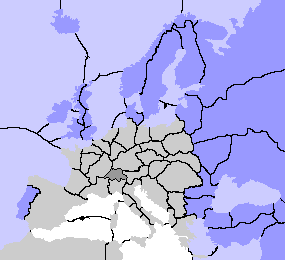In my previous two articles on stalemate positions I covered those positions which depend on control of England or Turkey as a base. Normally, these are the countries which head the stalemates.
Now that I am a Diplomacy publisher, I have begun trading with
other 'zines. In the present Hoosier Archives demonstration games
(1973BI) I discovered that the Russo-Turkish alliance, though
they lost control of the Balkans and were being destroyed in the
North, were managing to stave off the Austro-Italian alliance
((The game was won by France. The R/T alliance was a real flop.
Never held more than ten centers and in fact I and R were both
wiped out in the same year --- Mark Berch, Diplomacy Digest 10-11
(April--May 1978).)) Working with this as a basis, I set up
the following series of stalemates:

The success of this depends on the opposing alliance not controlling any fleets in the black sea or the Northern waters ((and also no fleets in either Gas or Spa(nc) --- Mark Berch, Diplomacy Digest 10-11 (April-May 1978). )). Note that the Northern section has an extra supply center, and that the Southern section requires the unit that is supplied in the North. The problem is to get a unit from the North into the very opposite end of the board.
It is necessary for the Russians to be involved in this; Russian
units are often spread from Turkey to England.
 Continuing, we expand the Northern section of the stalemate in
the manner described in my article on the Northern stalemates:
Continuing, we expand the Northern section of the stalemate in
the manner described in my article on the Northern stalemates:
Or the supply centers could substitute Den for StP, in which case A Swe S Nwy and A Den holds. An expansion to another supply center (all of Scandinavia and StP) has A Den H and a unit in Bar, Nwy, Fin or Bot supports A StP. This gives the alliance an extra supply center which enables the Southern front to lose control of the Aeg and assume the following Southern position:
A Con & A Smy H; A Syr S Smy; F Bla (or A Ank) S Con; A Arm H.
 A further expansion makes it apparent that Russia is the heart
of the stalemate position:
A further expansion makes it apparent that Russia is the heart
of the stalemate position:
Or the move to Aeg provides an extra unit.
The position is different in that is it not necessary to occupy Ukraine in order to hold Moscow and Sevastopol, so long as the Aegean is controlled.
The progression continues by transferring A Arm-Ukr and removing F Bal. Then A StP S Lvn; A Mos & A Sev S Ukr. Thus, more space is held with only 12 units, making Denmark expandable. With the extra unit available, there are alternative courses of expansion:
((And back to Lipton's article --- Mark Berch, Diplomacy Digest
10-11 (April-May 1978). ))
 Finally, the addition of War as a supply center lets a good deal
of pressure off the East. The supply centers are the same as position
III save that War is added.
Finally, the addition of War as a supply center lets a good deal
of pressure off the East. The supply centers are the same as position
III save that War is added.
A continued expansion along this route by taking Rumania and Bulgaria
enables the stalemated powers to hold their own; however, the
other side cannot; for there are then two free units that can
move about, tying up more units than the other side has supply
centers.
 However, if War is not taken, expansion into Rum and Bul can take
place without upsetting the stalemate.
However, if War is not taken, expansion into Rum and Bul can take
place without upsetting the stalemate.
And that appears to end of this series. Again, any further expansion to, say, Gre causes the other side to lack sufficient units to hold its position.
There are expansions that may take place in the West with the
overall positions remaining stalemated. These are left as problems
for the reader.... Any mistakes that appear are, naturally, the
editor's.